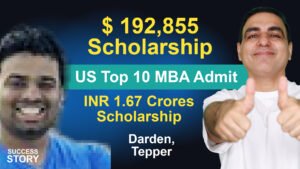The reason Stanford Graduate School of Business (GSB) has made it to the top of your target business school’s list is also the reason that blogs like this one exist. The school’s rankings and innovative programs has made it one of the most sought-after business schools, not only in the USA but around the globe.
Having one of the most exclusive and elite MBA programs, Stanford GSB has a meagre 6.1% acceptance rate. The lowest amongst top business schools around the globe. The school is also a part of the elite M7 business schools. Think of the M7 business schools as something close to the Ivy League for business schools.
It’s a group of 7 business schools whose deans and vice-deans meet up at least once a year to share any information they find worthwhile. These 7 business schools rank in the top 10 business schools in the world every year, with Stanford Graduate School of Business never ranking lower than number 2 in the lists.
Stanford GSB also has been ranking as the top business school in regards to average salaries received by fresh MBA graduates, which was $224,628 in 2019.
The accolades associated with the school’s name are numerous.
This is why time and again applicants have found themselves googling the question “What does it take to get into Stanford’s MBA Program?”. And time and again, we have looked turned to experts like business school admission committee members, and MBA admissions consultants, to answer these questions.
However, today we look at someone’s journey to answer this question. Someone who has recently been through the ordeal of cracking the Stanford GSB admissions code, a recent Stanford GSB grad Ashutosh.
But before we get to his story in his own words, let’s look at the most important factors to cracking Stanford.
- Trying to be the perfect Stanford candidate
Something you’ll notice through Ashutosh’s journey is that he never tried to fit a Stanford mold. He wasn’t trying to create a particular profile that had previously proven to be successful in cracking Stanford.
The same goes for you. Ashutosh’s journey is an important one to read, however, do not try to imitate it in hopes of getting into Stanford. What worked for someone might not work for you. The best way to create an exceptional profile is to play on the existing strengths you have.
Research what values Stanford GSB associates itself with. But don’t blindly add them to your application. Use this research to figure out which of these skills you possess and then back your claims up with proof of recent incidents.
Trying to be someone else on your Stanford application only spells trouble. Admissions committee members at Stanford GSB go through thousands of applications during their tenure at the school. They can sniff out inauthentic applicant profiles. Also, admissions committees are trying to put together a diverse class that can bring a variety of experiences, perspectives, and solutions.
So, not being a “perfect Stanford candidate” might turn out to be your selling point.
- Standing out in an overrepresented applicant pool
Now, this is a huge problem with a complicated solution.
Business schools tend to categorize applicants. Most often than not, it is based on the educational or professional background of the applicant. The most overrepresented pool of applicants, from India, would be people from the IT background.
The larger the pool you’re in, the harder you will have to fight to stand-out during MBA applications. An admissions committee member from Stanford recently revealed that about 85% of the applications they receive are admissible, i.e. they meet the statistical criteria to be admitted to the MBA program of the school.
And the acceptance rate is just over 6%. What about the remaining 79% of applicants that had the right statistics, i.e. GMAT score, GPA, and work experience? these are the applicants that failed to make an impact on the admissions committee.
Some ways to ensure that you stand out during MBA applications to Stanford are:
- Network intensively
While writing the essays for Stanford, you will come across an essay question which would in some form ask you “Why Stanford?”. Normally, you would research about Stanford online and sing its praises as you answer this question. However, this is a brochure answer. It’s an answer that Stanford could put in their brochure. They already know these facts. They know they are the best.
What they want to know is why you want to come to Stanford.
Networking with current students and alumni would help you find out information about Stanford’s programs, students clubs, professors, and projects, that could help you reach your post-MBA goals.
- Good recommendations
Choosing your recommenders wisely to ensure that they can comment on your professional capacity and would support your candidature is imperative. If your recommender seems hesitant to give you a letter of reference, moving one to another is the right step to take.
- Taking charge of your narrative
Your narrative is one of the most aspects of your MBA application to Stanford, if not the most important aspect. It determines the way the admissions committee will see you.
The mistake that a lot of applicants make in regards to the narrative is playing the victim or deflecting blame. When addressing a failure, or a weakness, applicants tend to focus on making themselves look spot-free by either playing the victim to situations or deflecting the blame on someone else. In both the scenarios you’re showing the admissions committee that you aren’t ready to accept responsibility for your actions.
Business schools truly appreciate applicants that take responsibility for their actions as it shows growth prospects in an individual.
Another narrative issue that many applicants face is not having a cohesive application. It simply means that the applicant’s past, the MBA, and their short-term and long-term goals do not line up.
Stanford admissions committee members know that many students will change their post-MBA goals as they get exposed to new opportunities during the program. However, a cohesive goals story gives them a surety that an applicant has a plan of action, and isn’t jumping into an MBA just for the sake of it.
Thus, not having a cohesive narrative of your past, the MBA, and your short-term and long-term goals might send your MBA application straight to the reject pile.

- Take time to figure out your answer
Have a drink. Take a walk. Take a vacation if you need to. Just don’t rush in to answer an essay question.
Even the best writers can be stumped when faced with a question that demands an answer with a philosophical view of themselves. When Stanford asks you “What matters most to you and why?”, don’t try to come up with the whole essay right away.
Come up with a one-sentence answer first. What comes to mind when this question is presented to you? Whatever the answer
(ALT TAG: Question mark with a white chalk on a Blackboard)
was, reject it and think of another answer. Reject the second answer as well and now come up with a third.
The third answer is the one that will really have you wondering and questioning all the decisions you have ever made. Good!
Psychologists say that when faced with a dilemma, the first answer that you give is how you have been conditioned to think. The second answer you give is motivated by what you wish to become. And the third answer is the true representative of who you are. Thus, the third answer is what we wish to show the admission committee members.
- Fitting in with the Stanford GSB value: The Leadership
The best way to describe your Stanford GSB MBA application journey is “fitting in by standing out”. Confusing?
Although you want to stand out during your MBA application, your goal should also be to portray compatibility with the school. While the school does love diversity, it still wants to see you portray a few skills like leadership. But the leadership you portray can be in your unique style.
The school’s motto is “Change Lives, Change Organizations, Change the World”. That simple statement can clarify how important creating future leaders must be to the school.
Moving on to Ashutosh’s story.
How to get into Stanford: From Ashutosh, Stanford GSB grad
My motto in life has always been “go big or go home.” And, this adage applies to my MBA journey as well. Once I decided to pursue an MBA, I made a conscious decision to aim for the top-tier B-schools. I was not ready to settle for less.
My choice of MBA colleges included Stanford, London Business School, MIT Sloan and IIM A – PGPX. I -was a bit apprehensive about choosing the most competitive business schools as my profile didn’t really stand out. I would be what one could consider a slightly above average candidate. I nonetheless decided to give it my best shot.
After making a list of preferred schools, I meticulously started preparing for the GMAT. With other aspects of my profile like – my work experience, my college degrees – less than stellar, I wanted to ace my GMAT.
At this juncture, while scouting for trusted MBA admission consultants, I chanced upon the PythaGURUS website. And, I should say this is when my MBA dreams begin to take shape. Connecting with Jatin Bhandari, the man behind PythaGURUS, was an eye-opener.
He didn’t give me false hopes. Neither did he discourage me. Instead, he gave me some concrete direction – I had to work exceptionally hard to get into the B-schools on my list. I knew that I had found the right counsellor I could trust.
My GMAT score was 720. While that’s considered a good score, I was disappointed that it wasn’t higher.
- The Stanford GSB MBA Applications
With my GMAT score in hand, the next step was to send in the applications. I decided to apply in Round-1 so that I could maximize my chances.
To say that I wrote and rewrote my MBA application essays countless times is an understatement. Every time I sent the drafts to Jatin, I received feedback within hours. And, the feedback was often brutal but always honest. After endless rounds of revisions, I had crafted a final version that not only pleased me but also got Jatin’s approval.
- My MBA Interview Experience
I was on cloud nine when I received interview calls from all three schools. Jatin and I spent several hours practicing and preparing my answers for the interviews. Together, we refined my answers for all common interview questions like – Why MBA? What are your short-term and long-term goals? Why this school? etc., as well as the curveball questions specific to each program.
Here’s a gist of my interview experience:
- Stanford Interview Experience
By now, I was prepared for all the regular interview questions. So, we focused on program-specific topics for the Stanford interview. This time I didn’t use my mobile connection to take the interviewer’s call. It went well, and I was hopeful.
As expected, I received the acceptance letter from Stanford on 9th December 2015. The day remains etched in my memory, as it was a life-long dream coming true.
I didn’t proceed with the MIT application as I had made it to my dream MBA program at Stanford.
- My Two Cents for MBA Aspirants
There’s no sugarcoating it – MBA admissions to the top programs are incredibly demanding and mentally as well as emotionally challenging. But, if you’re genuinely passionate about making it to the prestigious MBA institutes, go for it, don’t doubt yourself, even if you don’t have a top-notch profile.
Remember that MBA preparation is a journey, where you would often need support and guidance. I am incredibly grateful that I had Jatin to guide, inspire, and motivate me at every step of the way. Look for the right MBA consultant who will work with you and help bring out the best in you. While it may sound clichéd it’s true – give your best, and the sweet taste of success awaits.
Cheers!
We all can take away some important facts from Ashutosh’s experience applying to Stanford GSB’s MBA Program. First, you don’t need a 780 GMAT score to make it to Stanford. Although Ashutosh had a lower GMAT score than the average of Stanford’s MBA class, he made sure the rest of his profile would make up for the slight discrepancy.
Second, he worked hard for his Stanford admit. He didn’t have an exceptional profile, as he mentions, or wasn’t “lucky” during his MBA journey. Ashutosh put his sweat and tears into receiving the admit to his dream school. For every piece of feedback, he received, he went above and beyond to ensure he understood and applied to every section of his application.
The key takeaway from Ashutosh’s story, however, is that no matter what roadblocks you are faced with during your applications to an elite school, even Stanford, if you’re ready to put in the work, you too can get that admit!





